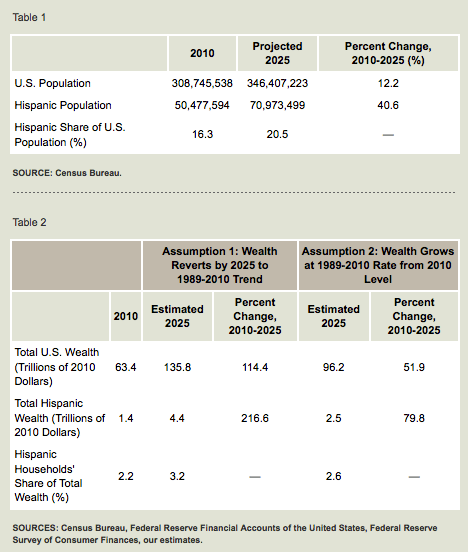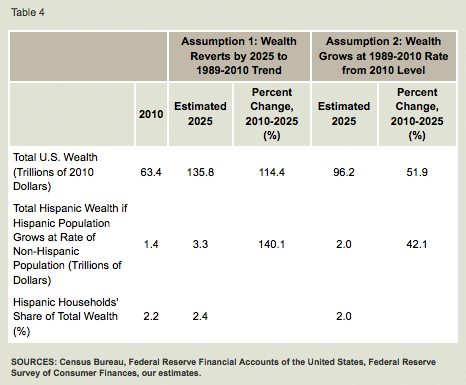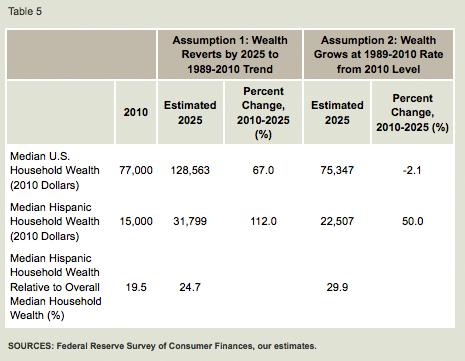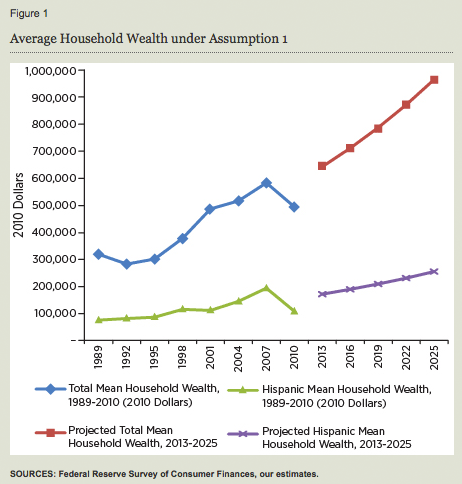Hispanic Population’s Share of Wealth Likely to Increase by 2025 [INSIGHT]
August 7, 2014
 Wealth owned by Hispanic families would triple in inflation-adjusted terms by 2025 if wealth-building trends observed during the past two decades resume. This would raise the share of total wealth owned by Hispanics to a new high. However, most Hispanic families would remain far less wealthy than white and Asian families. A substantial portion of the increased wealth would result from the Hispanic population growing faster than other groups, rather than from per-capita increases in wealth alone. And there is reason to be cautious about extrapolating previous wealth trends far into the future. Thus, the wealth outlook for Hispanic families is promising but far from certain.
Wealth owned by Hispanic families would triple in inflation-adjusted terms by 2025 if wealth-building trends observed during the past two decades resume. This would raise the share of total wealth owned by Hispanics to a new high. However, most Hispanic families would remain far less wealthy than white and Asian families. A substantial portion of the increased wealth would result from the Hispanic population growing faster than other groups, rather than from per-capita increases in wealth alone. And there is reason to be cautious about extrapolating previous wealth trends far into the future. Thus, the wealth outlook for Hispanic families is promising but far from certain.
Hispanic Families Are Less Wealthy Than Average, but Gaining
The U.S.’s Hispanic population was about 50.5 million in 2010, representing 16.3 percent of the total population (Table 1).1 According to the Federal Reserve’s Survey of Consumer Finances and its Financial Accounts of the United States, Hispanic families had about $1.4 trillion of net worth (wealth) in 2010, representing about 2.2 percent of total wealth (Table 2).2 The share of total wealth owned by Hispanic families was lower than their share in the population because average wealth per Hispanic household was only $108,871, compared to average household wealth of $543,702 among all non-Hispanic families.3 Table 3 shows that the average wealth of all households was $494,916 in 2010.
Using census projections of population growth through 2025 and two different assumptions about the trajectory of wealth gains between 2010 and 2025, we estimate that Hispanic families will own between $2.5 trillion and $4.4 trillion of wealth in 2025.4 This would represent between 2.6 percent and 3.2 percent of total U.S. wealth. We estimate that the majority of the gain will be due to faster population growth, but a small increase may occur due to faster growth of average household wealth.
Our two different assumptions address the uncertainty regarding whether the large wealth losses experienced between 2007 and 2010 will prove to be “permanent,” in the sense that subsequent wealth gains are, or are not, unusually rapid for a time. This is particularly important for Hispanic families, who suffered above-average wealth losses during the most recent recession.
Two Possible Wealth Scenarios
Under one assumption, we project that average wealth levels of Hispanic families (and of families overall) by 2025 will have reverted to the trend lines that best describe the 1989-2010 wealth data in the Survey of Consumer Finances (Figure 1). This would result in faster growth of the average wealth of Hispanic families than for the population overall, primarily because Hispanic families fell further below their trend line in 2010 than did non-Hispanic families and therefore have more wealth to make up to return to trend (Table 3).5 The average level of wealth among Hispanic families would increase from 22.0 percent of the level among all families in 2010 to 26.5 percent in 2025.
The alternative assumption projects that average wealth levels in 2010 grow from that crisis-impacted level at the rate observed on average between 1989 and 2010 (Figure 2). That is, the wealth losses suffered in the years leading up to 2010 would prove to be permanent in the sense that no “catch-up” period occurs.
The middle and far-right columns of tables 2 and 3 summarize our projections. Total Hispanic wealth is likely to grow considerably faster than overall wealth through 2025 under both assumptions about wealth gains (Table 2). The Hispanic share of total wealth would increase from 2.2 percent to 3.2 percent under the first assumption (reversion to 1989-2010 trend) and to 2.6 percent under the second assumption (average growth resumes from 2010 level). Table 3 shows that average Hispanic wealth per household would increase faster than for the entire population only under the first assumption, however. In the more pessimistic second scenario, the Hispanic share of total wealth would increase only because the Hispanic population is expected to grow faster.
The Importance of Population Growth
To isolate the role of relatively fast expected growth of the Hispanic population on wealth trends, Table 4 shows what total Hispanic wealth would be in 2025 under each assumption about average wealth gains if the Hispanic population grew at the same rate as the overall population. In particular, the projections assume that the Hispanic population grows only at the rate expected for the non-Hispanic population between 2010 and 2025—about 0.4 percent at an annualized rate versus the expected 2.3 percent rate among the Hispanic population. The result is that cumulative wealth gains among Hispanics would be only 140.1 percent under the first scenario and 42.1 percent under the second scenario. As Table 2 showed, the baseline wealth projections that assume faster Hispanic growth than the overall population resulted in cumulative gains of 216.6 percent and 79.8 percent, respectively.
Slow but Steady Progress Likely
Median wealth among Hispanic families—that is, the family that ranks exactly in the middle of the wealth distribution—was quite low in 2010 at $15,000. The median wealth among the entire population was $77,000. Nonetheless, we expect the wealth of the median Hispanic family to increase faster than the wealth of the median family in the overall population under both of our assumptions about future wealth gains (Table 5). This is primarily due to the extraordinary 39 percent decline in median wealth suffered by the entire population between 2007 and 2010. The decline among Hispanic families alone was about 32 percent, so a resumption of growth at the rate experienced between 1989 and 2010 among the entire population—in fact, a net decline—would result in further small declines in wealth through 2025 for the median family overall. The median Hispanic family would experience a larger cumulative wealth gain between 2010 and 2025 under both of our assumptions about future wealth trends.
In summary, we project the Hispanic share of total wealth to increase from 2.2 percent in 2010 to either 2.6 percent or 3.2 percent of the economy’s total wealth by 2025, depending on our assumption about wealth-building trends. If it were not for the faster rate of population growth projected for the Hispanic population, the wealth shares in 2025 would be 2.0 or 2.4 percent—that is, either a small decline or a small increase from their 2010 shares. Thus, relatively rapid population growth in the Hispanic population is likely to be an important contributor to the rising share of total wealth owned by Hispanics.

































